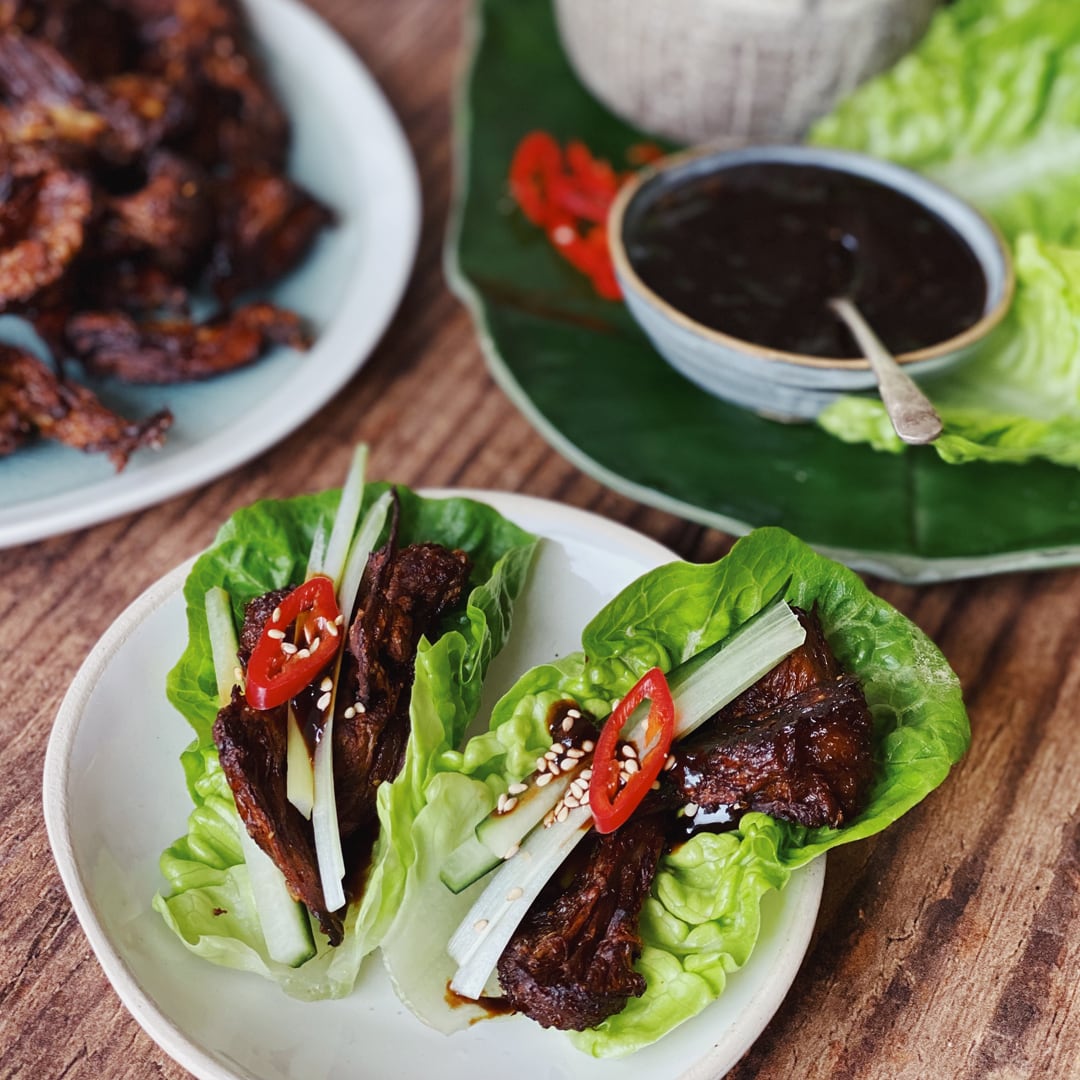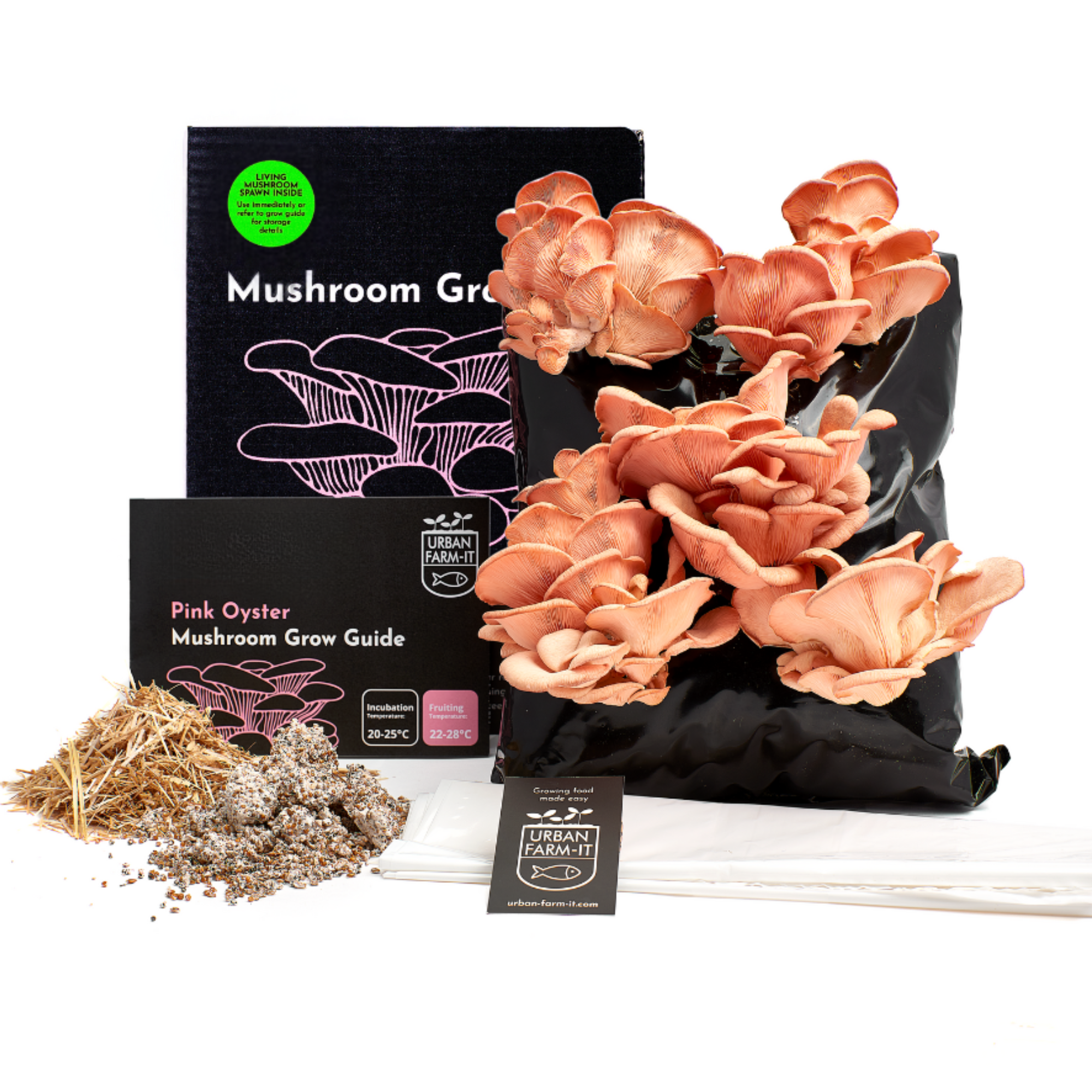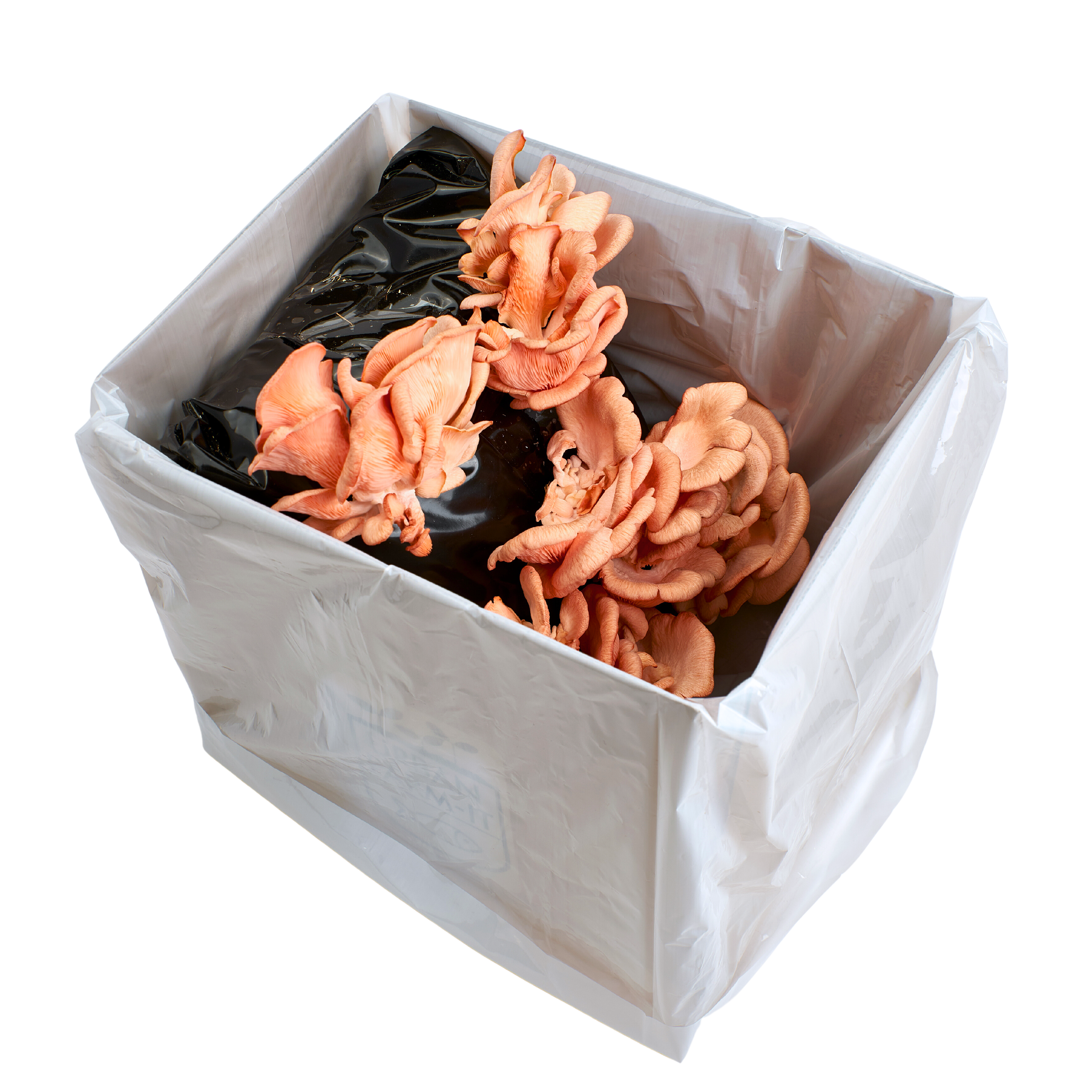Do oyster mushrooms pique your interest? Perhaps you want to look for oyster mushrooms growing wild in your neighbourhood. Or maybe you simply want to know how they taste before purchasing a pack from the shop, or you’re drawn to growing them yourself.
Mushrooms are a unique type of food. We use them as if they were vegetables, although they are fungi, not plants. You’ve probably heard of button or portobello mushrooms, which are widely used in everyday meals. However, you may have heard of another fungus that is gaining popularity – oyster mushrooms.
If you’re interested in learning more about oyster mushrooms, including how to use them and how to grow them, then read on. We’ll tell you everything you need to know about oyster mushrooms in this easy-to-understand guide.
Whether you're growing Lion’s Mane or oyster mushrooms, our mushroom growing kits give you the right environment for a healthy, flavour-packed harvest – check them out now.
- What Are Oyster Mushrooms?
- Where Can You Find Oyster Mushrooms in the Wild?
- What Do Oyster Mushrooms Taste Like?
- Nutritional Contents and Health Benefits of Oyster Mushrooms
- What substrates can be used to grow Oyster Mushrooms?
- Different Types Of Oyster Mushrooms
- How To Identify Oyster Mushrooms in the Wild
- How to Clean Oyster Mushrooms
- How to Store Oyster Mushrooms
- How to Grow Oyster Mushrooms
- Cooking With Oyster Mushrooms
- Conclusion
What Are Oyster Mushrooms?
Oyster mushrooms are a type of edible fungi that belongs to the Pleurotus ostreatus species. They grow naturally on trees and are eaten and grown in various countries but are particularly popular in China, Korea, and Japan.
There are 202 edible mushroom species in this popular edible fungi family, which is most typically encountered in its grey form. The caps are roughly oyster-shaped, which accounts for part of their name. Oyster mushrooms come in various sizes, shapes, and textures, and these will change based on the type of oyster mushroom you have.
The oyster mushroom has become a home grower favourite since it is one of the more straightforward mushroom varieties to raise. The oyster mushroom is an excellent beginner for new growers because it requires very little investment in your mushroom growing kit.
Oyster mushrooms can be found worldwide, including the United Kingdom and Ireland, the majority of mainland Europe, Asia, and parts of North America.
Oyster mushrooms were originally documented in 1775 by Dutch scientist Nikolaus Joseph Freiherr von Jacquin. Agaricus ostreatus was the original name for the mushroom. Most mushrooms with gills were grouped together in the Agaricus genus at the time.
Oyster mushrooms were moved to their own genus, Pleurotus, by a German mycologist named Paul Kummer in 1871, and this is still the scientific designation for oyster mushrooms today.
Since the 1940s, fresh oyster mushrooms have been commercially grown. They’re available in a variety of sizes and colours in a variety of marketplaces throughout the world. They’ve evolved into a vegetarian and vegan staple that is often used as a substitute for seafood or chicken.
In the 1980s, scientists actually discovered that oyster mushrooms are carnivores! The meat in question is nematodes, commonly known as roundworms, small animals with guts, nerves and muscles. Within minutes of contact, oyster mushrooms kill and paralyse nematodes, insert their filaments into the corpses, break down the contents, and absorb the slurry for nutrients.
Where are Oyster Mushrooms Native to?
Oyster mushrooms grow on and near trees in the world’s subtropical and temperate forests. They commonly grow on logs and dead standing trees as wood decomposers. They favour deciduous trees, mainly oak and beech. They prefer open, green woodlands and like to thrive in the shade.
Although it is found in many temperate and subtropical forests around the world, the oyster mushroom is not found in the Pacific Northwest of North America.
Physical Characteristics of an Oyster Mushroom
Natural examples range from white to grey to tan to dark brown; the border is inrolled when young, smooth, and commonly lobed or wavy. Because of the stipe arrangement, the flesh is white, solid, and varies in thickness.
The mushroom’s gills are white to cream in colour and descend on the stalk, if one is present. If this is the case, the stipe, or stem,is off-centre and has a lateral wood attachment. The mushroom’s spore print is white to lilac-grey, and it looks best against a dark background.
Oyster mushrooms often don’t have a stalk but when they do it’s usually short and dense.
Where Can You Find Oyster Mushrooms in the Wild?
In the wild, oyster mushrooms are generally light grey or greyish-brown in colour, although they are currently grown in various colours.
With broad, oyster- or fan-shaped crowns that are two to ten inches across, these mushrooms grow in clusters or shelf-like structures. Oyster mushrooms should have firm white flesh and white gills when purchased fresh.
Oysters have various dangerous look-alikes, the most notable of which is the Western Jack o’Lantern and the Ivory Funnel. Unless you’re foraging with the help of a professional, we always suggest you cultivate oyster mushrooms yourself. Growing your own oyster mushrooms can be easy with the mushroom growing kit.
When Are Oyster Mushrooms In Season?
Oysters have a long growing season, from spring to autumn. They thrive when the weather changes dramatically, such as after the first frost.
Oyster mushrooms are harvested all year by commercial growers, so they’re always available as long as your supermarket has them. Because most oyster mushrooms are cultivated indoors under controlled conditions, there is no such thing as a good or bad season as there is with other crops.
What Do Oyster Mushrooms Taste Like?
It’s not uncommon to hear oyster mushrooms described as having a slight anise flavour. They have a meaty feel when cooked, making them a popular meat substitute in vegetarian and vegan meals.
Both flavours are quite delicate, and once the mushrooms have been incorporated into a recipe, they are usually undetectable. They have a moderate taste with a subtle earthy undertone.
Nutritional Contents and Health Benefits of Oyster Mushrooms
Oyster mushrooms include about 65 calories per cup (86 grams), 10 grams of carbohydrates, less than 1 gram of fat, and about 5 grams of protein.
They are a healthy addition to any dish. Containing protein, as well as a variety of minerals and vitamins, including iron, potassium, and even calcium, every little bit helps when it comes to maintaining a healthy diet.
What substrates can be used to grow Oyster Mushrooms?
Oyster mushrooms can grow on several materials, including wood logs, sawdust, cardboard, coffee grounds, and agricultural byproducts like sugarcane bagasse and cotton waste, but straw is the most common substrate (wheat and oat straw do particularly well).
For more information on substrates, check out our comprehensive guide to mushroom substrates.
Different Types Of Oyster Mushrooms
The Pleurotus genus is worth exploring whether you’re looking for a new delicacy for your next kitchen experiment or want to try your hand at cultivation.
Although Pleurotus has over 200 species, these five common variants are the most likely to be produced and marketed.
Pleurotus ostreatus, the blue oyster mushroom, enjoys the cold. The more intense the blue colour is, the colder the temperatures are when the fruiting body develops. The blue oyster, which can be found in the wild, thrives in temperatures ranging from 7 to 18 degrees Celsius.
The high oxygen requirement of this fungus makes it quite difficult to cultivate at home. When there is too much carbon dioxide in the air, the mushroom develops a thick stem and a small-cap that lacks the brilliant colour of this variation.
However, under the appropriate conditions, this mushroom fruits fast and develops colourful caps in the early stages of development. It’s a good meat substitute because of its earthy, deep flavour.
The yellow or golden oyster mushroom, Pleurotus citrinopileatus, is a delicate, eye-catching species. The caps are modest, ranging in size from 2 cm to 6.5 cm wide, and are a lovely yellow tint.
Despite its rapid growth, Pleurotus citrinopileatus isn’t designed for the mass market. It doesn’t travel well, and excessive handling can cause the caps to shatter or tear. That’s why, in the spring and summer, you’ll nearly solely see them at farmers’ markets. This kind, fortunately, is simple to raise at home. It doesn’t need a lot of oxygen to thrive and can grow on various surfaces.
Yellow Oyster Mushrooms are native to eastern Russia, northern China, and Japan.
Pleurotus djamor’s vivid pink colour brings up ideas of flowers, flamingos, and salmon. This oyster mushroom species, delicate and textured, makes quite a statement on market stalls throughout the summer months.
Pleurotus djamor is a fast-growing mushroom that doesn’t stay long after being harvested. Being a native of Indonesia and other tropical regions, it enjoys hot weather and thrives in temperatures up to 30°C. The mycelium will perish if the temperature drops too low throughout the growth cycle below 10°C.
The thickness of the caps and whether or not a short stem arises are determined by the growing conditions. Caps range in size from 2 to 15 cm and have a distinct umami aroma.
Pink oyster mushrooms have a short shelf life and are difficult to transport. To bring out the taste, make sure to cook them thoroughly, whether in soups, stews, or pasta dishes. Despite their resemblance to seafood, they can be roasted to a crisp as a plant-based substitute for bacon.
Thanks to its huge, thick stems and compact caps, the King oyster stands out in specialist shops. In fact, to get this iconic shape, it is produced in settings with a lot of carbon dioxide.
These mushrooms can be found growing in areas around the Atlantic Ocean and the Mediterranean Basin. They can also be found in India, Central Europe, Northern Africa, and Western Asia.
The greater oxygen levels in the wild, on the other hand, result in larger caps than in cultivated Pleurotus eryngii specimens. This largest of all oyster mushrooms emerges as solitary fruits rather than bouquets, regardless of how they’re cultivated.
It’s a lot of fun to grow these mushrooms since you can experiment with the oxygen levels to achieve varied sizes of caps and stems. The thicker the stems, the better for cooking, and don’t worry if you have a bountiful harvest; king oysters will stay in the fridge for one to two weeks.
Although the white elm oyster mushroom grows on elm trees, the name “oyster” is a misnomer. This fungus isn’t even a Pleurotus; its formal name is Hypsizygus ulmarius, which places it in the same genus as white beech mushrooms (Hypsizygus tessellatus, or buna shimeji).
Why is it important to highlight this “imposter” mushroom?To begin with,it has a lot of potential for indoor cultivation. . It can withstand high amounts of carbon dioxide and produces far less spores than blue oyster types. The mushrooms are also edible, albeit they don’t have the same flavour as typical oyster mushrooms.
Hypsizygus ulmarius loves to grow in dense clusters of big caps that range in colour from white to tan in the wild on elm trees. Caps range in size from 6 to 15 cm but can reach 30 cm in length. The elm oyster’s stems can grow quite long and thick, which sets it apart from the bulk of Pleurotus types.
Young white elm oyster mushrooms are a North American type with a pronounced woody flavour that goes well in soups and stir-fries. Vegetarian and vegan recipes can use more mature specimens in place of meat.
How To Identify Oyster Mushrooms in the Wild
Oyster mushrooms grow in bunches called shelves on rotting or fallen logs in nature. So if you find one, there’s a good chance you’ll find a bunch more nearby. Cultivated oyster mushrooms prefer to grow in smaller clusters, but they can still create huge clusters.
Look for oyster mushrooms hiding in logs, fallen trees, or dead standing trees. Check below fallen trees as well, as oysters prefer to grow in the shade. They prefer to live in old, lush, open forests, where they can grow on oak and beech trees.
Oyster mushrooms have a fast growth rate. If you don’t find them when they’re still young, they’ll become leathery and unfit to eat.
Cap
The cap is broad and fan-shaped (or oyster-shaped). The length ranges from 5 to 25 cm. The colour is usually white or grey; however, it can also be tan in some areas. It might be wavy or lobed.
Gills
The gills of oyster mushrooms are decurrent (they extend down the stem). This indicates that they are attached to the stem and run its length. The gills of most oyster mushrooms are white.
Stem
The majority of oyster mushrooms lack a stem. If they do have a stem, it will be small and stubby, and it will grow off-centre most of the time.
The stems of oyster mushrooms growing on top of a log may be more developed than those growing on the side. There is neither a sack nor a rim at the base of the stem.
Spore Print
On a dark background, look for spore prints on your oyster mushrooms. White or a lilac-grey colour should be used for the spore print.
Smell
Oyster mushrooms have a distinct odour that is best characterised as “oyster mushroom,” but it won’t make sense until you try them! People generally describe them as smelling slightly fishy or sea-foody, and they’re frequently related to anise.
Growing Location
The oyster mushroom can be found in abundance in the woods of the United Kingdom. It thrives on hardwood trees, especially deciduous trees like beech.
How to Clean Oyster Mushrooms
Cleaning oyster mushrooms isn’t particularly difficult. They don’t come into contact with dirt very often because they grow on wood. All you have to do is wipe them away with a paper towel most of the time.
It’s fine if you want to rinse them to make sure you get all of the dirt and grit out. Just make sure your mushrooms aren’t submerged in water for too long.
How to Store Oyster Mushrooms
Oysters, like all mushrooms, are sensitive and degrade quickly if not stored properly. They have a vast surface area and can dry out rapidly due to their flat design.
If you come across a large number of oyster mushrooms in the wild, you can freeze or dry them to preserve them:
To freeze: Boil oyster mushrooms for around 3 minutes and then rinse them with cold water, drain them well, and place them in freezer bags.
To dry: Preheat your oven to 65°C. Cut the mushrooms into half-centimetre thick slices and place them on baking pans. Bake for an hour, then flip the mushrooms and bake for an additional hour. If they aren’t entirely dry after 30 minutes, flip them and wait another 30 minutes. Allow to cool to room temperature before placing in an airtight container.
Place your oyster mushrooms in a dish of warm water to rehydrate them.Though oyster mushrooms do not need to be soaked before use in most cuisines. Simply add them to your recipe and they should absorb all of the liquid they need in a matter of minutes.
How to Grow Oyster Mushrooms
Oyster mushrooms are one of the easiest mushrooms to cultivate at home since they can be grown on a range of substrates.
You can find a complete step-by-step instructions to growing oyster mushrooms here.
We also sell oyster mushroom kits that have already been inoculated and incubated. All you have to do is cut your kit open every day and sprinkle it with water. You’ll have your own wonderful oyster mushrooms in two weeks.
Cooking With Oyster Mushrooms
Oyster mushrooms are delicious sautéed and served as a side dish or in a stir fry.
When cooking them, make sure to provide enough room for the moisture to evaporate. If you overcrowd them, they’ll turn soggy and steam instead of being properly sautéed.
Oyster mushrooms are particularly delicious in soups and stews, and you may serve them to babies aged six months and up who are ready to explore solid foods.
Some people coat in breadcrumbs or batter oyster mushrooms in flour before deep-frying them to make deep-fried mushrooms.
They’re fantastic as a pizza topping or in pasta sauces. Basically any dish that calls for button or portobello mushrooms.
Conclusion
Oyster mushrooms are a tasty and healthy mushroom. They’re simple to cultivate and grow fast. Whether you buy oyster mushrooms at the supermarket or at a farmers market or try your hand at growing them yourself, we hope our guide has inspired you to include these delectable delicacies in your meals or in your garden.













Share:
Types of Mushrooms